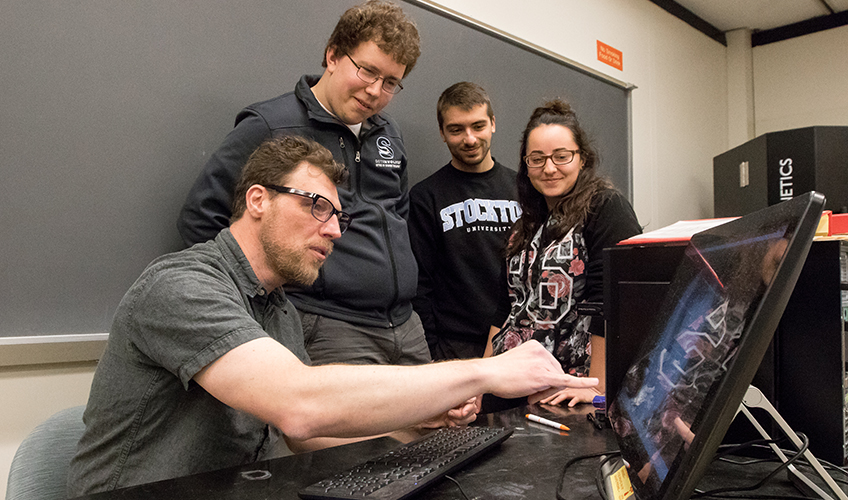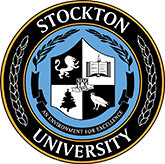Biology Faculty Research
The BIOL faculty offer expertise across a wide range of Biology-related disciplines. Click on the individual names below for faculty websites, research interests, publications, and contact information.

Dr. Matthew F. Bonnan
Professor of Biology
Dinosaurs, Vertebrate Paleontology, Functional Morphology, Animal Kinematics
Dr. Bonnan is interested in three broad but interconnected areas of research: 1) the
evolution of dinosaur locomotion, particularly in the giant, long-necked sauropod
dinosaurs; 2) the evolution of an erect posture from a sprawled posture in dinosaurs
and mammals; and 3) the evolution of pronation and supination in the forelimb of tetrapods.
To these ends, he has utilized traditional anatomical approaches as well as state-of-the-art
computer modeling to understand and infer how the limbs of both extinct and extant
tetrapods have evolved and adapted. Currently, he has begun to utilize XROMM (X-ray
Reconstruction of Moving Morphology) to produce three-dimensional animations of small
animal bones in vivo. His current research focuses on the three-dimensional kinematics
of lizard and mammal forelimbs, as a means to "reverse engineer" how early dinosaur
and mammal relatives may have moved and stood.
Dr. David W. Burleigh
Associate Professor of Biology
Reproductive biology, placental physiology and gene expression
Dr. Burleigh has studied various aspects of placenta physiology and development. In an effort to further the understanding of gestational diabetes on fetal development, Dr. Burleigh has studied the effects of glucose on the secretion of placental growth hormone by placental cytotrophoblast cells, examined the temporal expression of Growth Differentiation Factor 15 in rodents during development, and studied the physiological impact of advanced glycation end products (AGEs) on placental trophoblast cell development and gene expression
Dr. Michael Law
Associate Professor of Biology
Throughout their lifetimes, cells are constantly bombarded by an ever-changing environment. They integrate these environmental changes with information about themselves to make important decisions of cell fate. Mistakes in these processes can lead to developmental defects or cancer. Research in Dr. Law's laboratory is interested in understanding how cells integrate information about themselves and their environments to make the correct cell fate decision. Using the budding yeast S. cerevisiae as an experimental model, we are currently focusing on the roles of post-translational histone modifications in controlling yeast cell fates. To understand this question, we regularly employ genetic, molecular, biochemical, and genomic approaches.
Dr. Tara Harmer Luke
Professor of Biology
Molecular systematics, bioinformatics, marine microbial ecology, and symbiosis
Dr. Luke is interested in the molecular evolution in prokaryotes and has studied genes responsible for carbon fixation and utilization in phototrophic and chemoautotrophic bacteria, including archaea found in the deep sea. With a broad interest in marine microbial ecology, Dr. Harmer has studied the relationship of the giant tubeworms from deep-sea hydrothermal vents and their bacterial symbionts. Dr. Harmer is also interested in bioinformatics and participated in annotation of a microbial genome Thiomicrospira crunogena, a free-living chemoautotrophic-proteobacterium found at deep sea hydrothermal vents.
Dr. Craig Lind
Associate Professor of Biology
Physiological Ecology, Endocrinology, Reproduction, Herpetology
Dr. Nathaniel Hartman
Associate Professor of Biology
Neuroscience, stem cells, developmental biology
Dr. Hartman has a sharp interest in the development of the nervous system. Using targeted genetic approaches, Hartman investigates how molecular pathways guide neural stem cell behavior and how alterations in these pathways can lead to devastating neuropathologies. His recent work examines how the mammalian target of rapamycin (mTOR) pathway affects fate decisions of neural stem cells.
Dr. Michael R. Lague
Professor of Biology
Human evolution, skeletal biology, morphometrics, size & scaling, paleontology
Dr. Lague's research focuses on the postcranial skeleton of early hominins (humans)
such as Australopithecus, Paranthropus, and early Homo. Although fossil hominin specimens
are all housed in African museums, Dr. Lague has amassed a large collection of 3D
scans of fossil postcrania that can be used for collecting measurements (via a computer)
and can be printed with a 3D printer. The 3D scan collection includes bones of modern
primates (including modern humans) that can serve as a comparative context for investigating
questions related to taxonomy and limb function in early hominins.
Dr. Margaret E. Lewis
Professor of Biology
Paleontology, vertebrate anatomy, anthropology, paleoecology, evolutionary biology, forensics
Dr. Lewis' primary research involves reconstructing the behavior and ecology of extinct
members of the Order Carnivora1 by studying the functional morphology of the postcranial
skeleton (and skull where appropriate). A second research interest includes how carnivoran
behavior, ecology and evolution has impacted on and been impacted upon by human evolution.
I am particularly interested in how our hominin ancestors may have influenced the
structure of carnivore guilds and what role they may have played in the extinction
of larger carnivorans.
Dr. Ekaterina Sedia
Professor of Biology
Plant ecology, community dynamics, non-vascular plants
Dr. Sedia worked on a variety of projects studying plant ecology and community dynamics
of the New Jersey Pinelands. Her main interests are lichens and non-vascular plants,
and the effects they have on post-fire regeneration of vascular plants as well as
soil microbial activity. She has also participated in collaborative projects, including
a study of the effects of salinity on establishment of Atlantic white cedar, and a
project examining the role of fire and clear-cutting in survival of broom crowberry,
a Pinelands endangered species.
Dr. Peter F. Straub
Distinguished Professor of Biology
Impact of polluted environments on gene expression patterns in fish
Dr. Straub has been involved in developing biomarkers of pollution in marine fish.
This work involved cloning and sequencing differentially expressed genes from the
livers (and other organs) from contrasting habitats. The isolated genes are be studied
by quantitative PCR and microarray analysis to determine which are suitable biomarkers
of pollution. In addition, Dr. Straub has analyzed the fish for organic contaminants
including PCB’s and pesticides.


